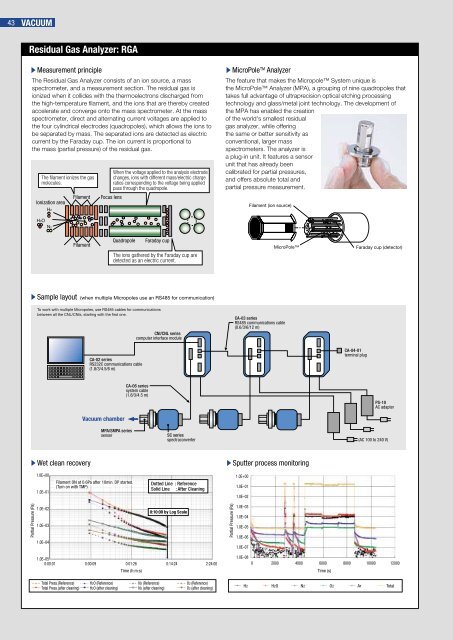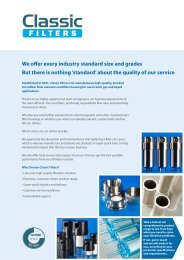SEC-400series - Shavo Technologies
SEC-400series - Shavo Technologies
SEC-400series - Shavo Technologies
Create successful ePaper yourself
Turn your PDF publications into a flip-book with our unique Google optimized e-Paper software.
43<br />
VACUUM<br />
Residual Gas Analyzer: RGA<br />
sMeasurement principle sMicroPole Analyzer<br />
The Residual Gas Analyzer consists of an ion source, a mass<br />
spectrometer, and a measurement section. The residual gas is<br />
ionized when it collides with the thermoelectrons discharged from<br />
the high-temperature filament, and the ions that are thereby created<br />
accelerate and converge onto the mass spectrometer. At the mass<br />
spectrometer, direct and alternating current voltages are applied to<br />
the four cylindrical electrodes (quadropoles), which allows the ions to<br />
be separated by mass. The separated ions are detected as electric<br />
current by the Faraday cup. The ion current is proportional to<br />
the mass (partial pressure) of the residual gas.<br />
The filament ionizes the gas<br />
molecules.<br />
Ionization area<br />
H2O<br />
H2<br />
N2<br />
Filament<br />
Filament<br />
Focus lens<br />
When the voltage applied to the analysis electrode<br />
changes, ions with different mass/electric charge<br />
ratios corresponding to the voltage being applied<br />
pass through the quadropole.<br />
Quadropole Faraday cup<br />
The ions gathered by the Faraday cup are<br />
detected as an electric current.<br />
sSample layout (when multiple Micropoles use an RS485 for communication)<br />
Partial Pressure (Pa)<br />
To work with multiple Micropoles, use RS485 cables for communications<br />
between all the CNL/CNIs, starting with the first one.<br />
1.0E+00<br />
1.0E–01<br />
1.0E–02<br />
1.0E–03<br />
1.0E–04<br />
CA-02 series<br />
RS232C communications cable<br />
(1.8/3/4.5/6 m)<br />
Vacuum chamber<br />
Filament ON at 0.6Pa after 10min. DP started.<br />
(Turn on with TMP)<br />
CNI/CNL series<br />
computer interface module<br />
CA-06 series<br />
system cable<br />
(1.8/3/4.5 m)<br />
MPA/SMPA series<br />
sensor SC series<br />
spectraconverter<br />
Dotted Line : Reference<br />
Solid Line : After Cleaning<br />
0:10:00 by Log Scale<br />
1.0E–05<br />
0:00:01 0:00:09 0:01:26 0:14:24 2:24:00<br />
Time (h:m:s)<br />
The feature that makes the Micropole System unique is<br />
the MicroPole Analyzer (MPA), a grouping of nine quadropoles that<br />
takes full advantage of ultraprecision optical etching processing<br />
technology and glass/metal joint technology. The development of<br />
the MPA has enabled the creation<br />
of the world's smallest residual<br />
gas analyzer, while offering<br />
the same or better sensitivity as<br />
conventional, larger mass<br />
spectrometers. The analyzer is<br />
a plug-in unit. It features a sensor<br />
unit that has already been<br />
calibrated for partial pressures,<br />
and offers absolute total and<br />
partial pressure measurement.<br />
Filament (ion source)<br />
CA-03 series<br />
RS485 communications cable<br />
(0.6/3/6/12 m)<br />
sWet clean recovery sSputter process monitoring<br />
Total Press.(Reference)<br />
Total Press.(after cleaning)<br />
H2O (Reference)<br />
H2O (after cleaning)<br />
N2 (Reference)<br />
N2 (after cleaning)<br />
O2 (Reference)<br />
O2 (after cleaning)<br />
Partial Pressure (Pa)<br />
MicroPole Faraday cup (detector)<br />
CA-04-01<br />
terminal plug<br />
PS-10<br />
AC adapter<br />
(AC 100 to 240 V)<br />
1.0E+00<br />
1.0E–01<br />
1.0E–02<br />
1.0E–03<br />
1.0E–04<br />
1.0E–05<br />
1.0E–06<br />
1.0E–07<br />
1.0E–08<br />
0 2000 4000 6000 8000 10000 12000<br />
Time (s)<br />
H2 H2O N2 O2 Ar Total




